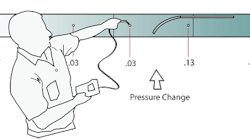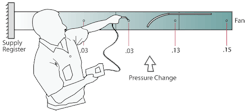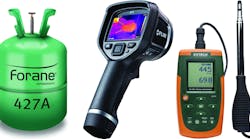Turtle In a Duct
I once got a call from a customer with a lost turtle. Megan was an old high school friend with 4 kids and a three story home. A return duct had been cut into the floor of an upstairs playroom, and the grille was cut into the closet door. The kids left the closet door open and the turtle crawled into the duct and disappeared.
My mission, should I decide to accept it, was to locate and rescue the turtle and return him safely to the arms of his anxious fan club. Frankly, I was a bit fearful of diced turtle in the fan as the return duct had no dampers.
After significant inspection accompanied by four frantic kids between the ages of 4 and 9 assisting me, we had narrowed the search to a long return duct that stretched across the basement. There was a .02-in. w.c. pressure drop over one section of straight duct, the drives and a section of duct was removed and low and behold, there was the turtle.
The reunion was sweet. The kids and Megan were delighted. Although we often have appreciative customers as we improve comfort and efficiency, I’ve rarely seen customers so emotional and overjoyed. I had a great time too, as air and pressure diagnostics saved the day once again.
Non-Turtle Duct Obstructions
Rarely are duct obstructions alive, unfortunately if they were once living, the pressure drop over the carcass only increases as time goes by, especially in heating season.
The most common duct obstructions come from loose duct insulation in rectangular ducts or internal damage in round or flex duct.
If the duct damage is evident from inspection, pressure testing often isn’t needed. It’s when the duct obstruction is not apparent from the outside of the duct when pressure diagnostics comes in handy.
Pressure diagnostics allows you to pinpoint the duct obstruction without having to tear apart the duct to inspect where the blockage may or may not be located.
How to Test
Your test instrument is a low-pressure digital manometer with a range from 0-in. to 1-in. w.c. You will need a 3 to 4 foot length of tubing and a static pressure tip. Attach one end of the tubing to the static pressure tip and the other end to the manometer.
If testing a supply duct, use the pressure port identified by a (+). If measuring a return duct, use the pressure port identified by a (-). You will also need a drill with a 3/8-in. drill bit and a handful of plastic hole plugs to stop the air from leaking through the test holes when your job is completed.
Measure the pressure at the end of the duct nearest to the fan. In a low-pressure residential or light commercial system, a typical pressure will be from .20-in. w.c. to .10-in. w.c. This pressure is evidence that you have airflow available at this end of the duct.
Measure the pressure at the far end of the duct before the register or grille and if the blockage is serious, you’ll find little or no pressure. You can also use a balancing hood to verify the limited amount of airflow at the grille.
With pressure verified and recorded at the end of the duct near the fan, drill a series of test holes every 4 feet or so down the duct away from the fan.
Measure the pressure at each test hole working away from the fan. You will locate the obstruction where you find a significant decrease in pressure between two of the test holes as shown in the illustration below.
You may drill additional test holes and complete additional pressure testing to pinpoint the exact location of the blockage.
Eureka, I’ve found it!
The point you identify the highest pressure difference is the location of the duct obstruction. This test works in any type of ducting including flex duct.
Mark the location of the restriction on the outside of the duct. Take time to plug the test holes in the duct. Plastic hole plugs work well for sheet metal duct. Tape works well for flexible duct. The added precaution of sealing the inner liner of flex duct with a squirt of spray foam is recommended in humid climates to avoid condensation.
Now Fix It
Once the location of the obstruction has been pinpointed, surgically cut into the duct and remove the obstruction. The nature of the obstruction may require a section of the duct to be removed and replaced.
The location of the obstruction and accessibility may make the job easier or more difficult. It’s our job to see the obstruction is removed and that airflow is restored.
Some obstructions may be due to poor installation conditions also, so perhaps removing a restrictive elbow or fitting may make the needed correction. Flex duct obstructions can be caused by the duct not being pulled tight from one end or another or strapping that cuts into the duct.
Whatever the problem is, it can be identified and repaired to restore and deliver comfort to your customers, perhaps for the first time since the system was built.
Measure airflow at the grille or register when the repair is completed and compare measured airflow to the airflow required by design to keep the room comfortable and provide required ventilation. This verification step is essential for your peace of mind and to assure your customers of a job well done.
Rob “Doc” Falke serves the industry as president of National Comfort Institute an HVAC based training company and membership organization. If you're an HVAC contractor or technician interested in a free procedure of how to measure HVAC system pressures, contact Doc at [email protected] or call him at 800-633-7058. Go to NCI’s website at nationalcomfortinstitute.com for free information











